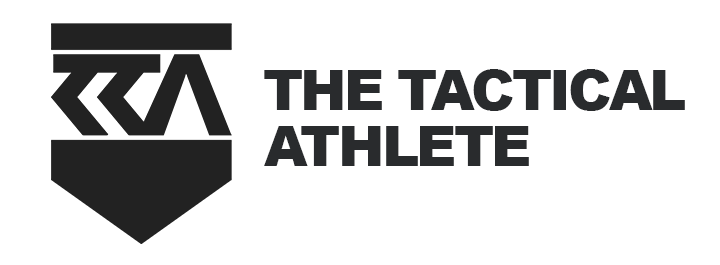News & Articles
By Farren Morgan
& Tactical Athlete Team

By Ruben Tabares
•
02 May, 2024
The Importance of Nutrition for Athletes and Soldiers Nutrition today is as complicated as it has ever been. 30 years ago, you would be hard pressed to find any books on nutrition yet today there are whole floors dedicated to this subject. Being an ex-international athlete myself and being widely known as the guy who got David Haye into exceptional shape it wasn’t too complicated because there were very few people in charge, Adam Booth, exceptional boxing coach and master tactician, Kevin Lidlow, in my opinion the best physiotherapist in the world and myself, looking after Strength & Conditioning, nutrition and Sports Therapy. Everyone had their own specific role, we communicated well, and the outcome was David became heavyweight champion of the world. Nutrition is much the same, it is best kept simple, effective and when the body is getting what it needs, no more no less, it is a remarkable machine, and anything is possible when it comes to performance. Where to start: Sleep and Water: When these two things are in sync and you’re getting enough of them both everything else in terms of performance can fall into place. We should be sleeping eight hours a night, more if you are placing a high physical, mental and emotional demand on the body, and this goes for both athletes and soldiers. When I was an athlete, I would sleep up to 10 hours a night and have a two-hour nap in between sessions during the day. Water is the next big thing which is often overlooked. With up to two litres of water lost during the night through perspiration and respiration and a further 1 litre during the day sweating even if not visible, it is safe to say that very few people, athletes and soldiers are drinking three litres of water per day. The rule is three litres per day plus half a litre per hour of exercise. This will ensure not only that you replace lost fluids but that you function at optimum levels. Water is vital for brain function, digestion, absorption of nutrients (if not properly hydrated and or dehydrated, no matter how well you are eating you will not absorb nutrients optimally, forms the basis of blood, digestive juices and is contained in muscle, fat and bones. It is safe to say that without a properly hydrated body not only will you not perform at your best, but it becomes increasingly difficult to not only digest food but to absorb it. As the body cannot store water, we need a fresh supply on a daily basis to make up for water loss from the lungs, skin, urine and faeces. So we have covered water and sleep, now let us look at digestion and absorption, or salt and probiotics. Salt is as vital as water, but you have to have the right ones as not all salt was created equal. Himalayan pink salt has finally got the recognition it deserves, it contains around 75 minerals needed for optimum performance. However, my personal favourite is Celtic Sea Salt which has around 85 minerals including three different types of magnesium which help drive water into the cells aiding in proper digestion. We also need adequate levels of sodium and chloride to make Hydrochloric acid in order to digest food properly. Beware of table salt which only has two minerals, sodium and chloride and is directly responsible for so many health complaints. Probiotics are also of vital importance when it comes to general gut health, immune system function and so many other things which scientific research is discovering on a daily basis. One of those things is nutrient absorption. In fact, different probiotics do have different roles within the body and indeed between men and women. For example, Acidophilus Rhamnosus helps women stay slim, helps with UTI’s and that time of the month. Now we have covered the basics let us look at what foods to stay away from. This all depends on what levels of discipline you are willing to put yourself through. Personally, non-negotiables for me are wheat, dairy and sugar. I suffer from Hay fever and as long as I stay away from the big three from January to September I am always hayfever free. What constitutes a well-balanced diet: When eating fish, chicken or red meat as a general rule of thumb try to stick to a portion as big as the palm of your hand. Depending on your energy requirements the portion size of carbohydrates should be small especially if you are carrying excess fat and again a handful of green vegetables. If losing weight try to stay away from carrots, beetroot etc. Every meal should have a spoonful of fermented vegetables to aid in digestion such as Kimchi, sauerkraut or pickles. Fermented vegetables also help stop sugar cravings. It is that simple, once you start adding energy drinks, energy and protein bars which are all full of sugars and ingredients which the human body doesn’t like you start not only toxifying but having extra calories to burn in the form of fat. I would also advise that you stop drinking water 30 minutes before your meals and start drinking 45 minutes after. If you have any questions about nutrition, please feel free to contact us.
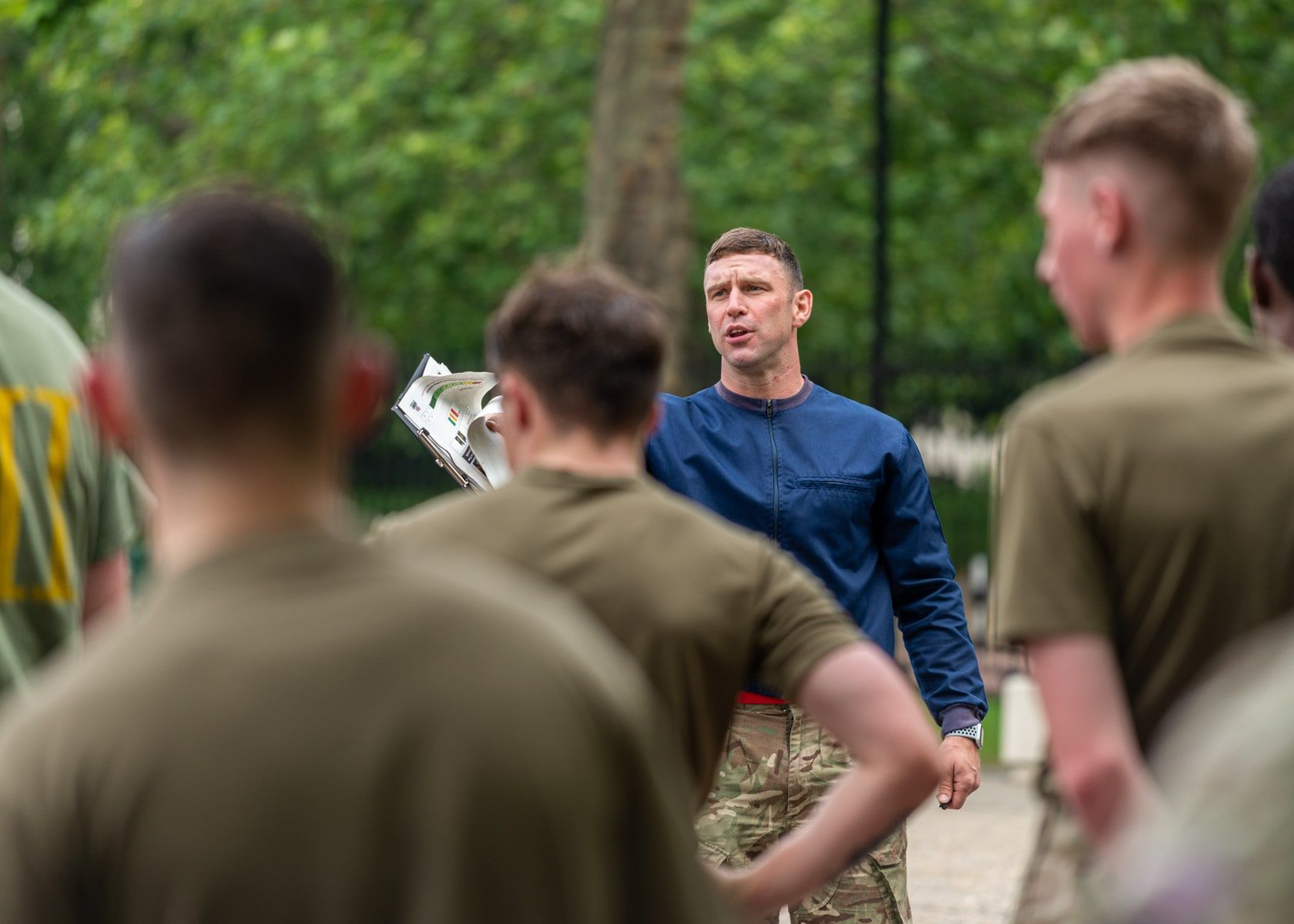
By Connor Sinclair
•
27 Apr, 2024
The Broad Jump: A Key Element in the Soldier Conditioning Review and the utilisation of the Kettlebell Swing for performance. The broad jump is a pivotal component of the Soldier Conditioning Review (SCR) of the British Army, underscoring its utility as an effective tool for assessing lower limb power. Its adoption beyond the British Army, notably in rigorous testing protocols like the NFL combine, is a testament to its effectiveness. The NFL Combine, renowned for featuring some of the most powerful athletes as evidenced by their performance, also incorporates the broad jump in its evaluations. What sets the broad jump apart is the distance achieved and the technique employed throughout the jump, particularly during the descent. Mastery of the descent—owning it—is crucial. The quality of the takeoff, regardless of its impressiveness, is negated if the landing is poorly executed. A proper landing technique is essential for dissipating force efficiently. This involves landing in a semi-squat position with bent knees, allowing the hips to sink back. Such a posture ensures the force is absorbed effectively, preventing the momentum from propelling the body forward, which could result in a stumble and a failed attempt. Moreover, it's critical that the knees align directly over the ankles upon landing, without collapsing inward. This alignment prevents undue stress on the joints and tendons, safeguarding against injury. Observing athletes frequently falter in this aspect, I emphasize the importance of a controlled, semi-squat landing as a reliable method to secure a successful jump. The broad jump is more than a measure of lower limb power; it offers comprehensive insights into an athlete's technique, control, and physical preparedness. Emphasising the technique of the descent as much as the takeoff can significantly enhance performance and prevent injuries, making it a fundamental aspect of training for the broad jump. For athletes aiming to elevate their jumping prowess, mastering the kettlebell swing is indispensable. Despite the ubiquity of kettlebells in gyms and their proven efficacy, skepticism remains among some athletes and coaches. Traditional exercises like squats, deadlifts, and plyometrics are undeniably beneficial, yet kettlebell swings offer unique advantages that warrant their inclusion in any comprehensive training regimen. Here's why the kettlebell swing stands out as an exceptional exercise for athletes: Fast-TWITCH MUSCLE FIBER ACTIVATION: The kettlebell swing is particularly effective at engaging fast-twitch muscle fibers, crucial for explosive movements like jumping. Biomechanical Relevance: The exercise boasts a high biomechanical transfer to jumping, enhancing leaping ability through its dynamic hip extension movement. Hip Overload: When executed correctly, kettlebell swings provide significant overload to the hips, a key factor in developing power for jumps. Grip Strength: Beyond its benefits to jumping, the swing also builds outstanding grip strength, an often-overlooked aspect of athletic performance. Posterior Chain Development: The kettlebell swing targets the glutes, hamstrings, and the entire posterior chain—areas frequently identified as weak links in many training programs. Regular practice of this movement leads to noticeable improvements. Eccentric Loading: It offers strong eccentric loading of the posterior chain, vital for muscle strength and resilience. Back Protection and Strengthening: Kettlebell swings also protect and strengthen the back, contributing to overall athletic durability. Accessibility and Safety: Kettlebell swings are straightforward to learn, minimizing the risk of injury and ensuring a low "stupidity factor." The secret to leveraging kettlebells effectively lies in their application to generate force. Specifically, when executing swings or snatches, the goal is to actively drive the kettlebell downward. This technique amplifies the force produced, pivotal for those aiming to enhance strength or speed. Achieving this requires the recruitment of the largest motor units within our muscles. There are two primary ways to engage these units: by lifting heavy weights or moving weights with high velocity. Interestingly, our spinal cord houses regulators known as Renshaw cells, which play a crucial role in this process. They selectively activate the largest and quickest motor units while inhibiting the smaller, slower ones. Thus, to boost power, training must focus on either high force or high velocity. Traditional powerlifting addresses the high force aspect effectively, but when it comes to high velocity, kettlebell exercises, particularly swings, excel. Kettlebell swings, categorized under low inertia training, optimize kinetic energy and engage involuntary muscle responses, such as the stretch-shortening cycle—a key component in plyometric training—to a greater extent than traditional heavy weightlifting. While heavy lifting remains a vital part of training, I advocate for the inclusion of kettlebell swings for their plyometric qualities. This preference stems from the unique ability of kettlebell swings to achieve higher hip joint velocity through actively accelerated ballistics, where the weight is propelled downward faster than gravity's pull. Moreover, the kettlebell swing stands out for its safety and ease of learning. Success hinges on mastering a few critical coaching points, making it an accessible yet powerful tool in any athlete's training regimen. On my power development days, I strategically incorporate kettlebell swings to leverage the benefits of Post-Activation Potentiation (PAP). This phenomenon boosts muscle performance after engaging in high-intensity exercise. The dynamic and explosive nature of kettlebell swings primes the nervous system and enhances muscle recruitment, setting the stage for improved performance in explosive movements, such as jumping. Following a series of swings, I often proceed with a double jump. This not only capitalizes on the PAP effect but also intensifies the plyometric training by focusing on the precision of the final jump's landing. Thus, the kettlebell swing serves a dual purpose: it provides a PAP effect that enhances subsequent jumps and delivers the comprehensive benefits discussed earlier in this blog. If faced with the decision to choose only one exercise to practice for the rest of my life, my unequivocal choice would be the kettlebell swing. This preference is grounded in its exceptional ability to foster power development, enhance the posterior chain, and engage a significant number of motor units simultaneously. Its simplicity belies its effectiveness, allowing for safe execution with minimal instruction. Most notably, it induces a "what the hell" effect— an unexpected improvement in various physical capacities without directly training those areas. While a comprehensive program ideally incorporates both kettlebell swings and traditional weightlifting, for those seeking a straightforward exercise to boost their broad jump, the kettlebell swing is unparalleled. It complements plyometric training perfectly, but I would emphasize the importance of mastering deceleration and achieving a solid landing. If you have any questions about broad jumps, please feel free to contact us.
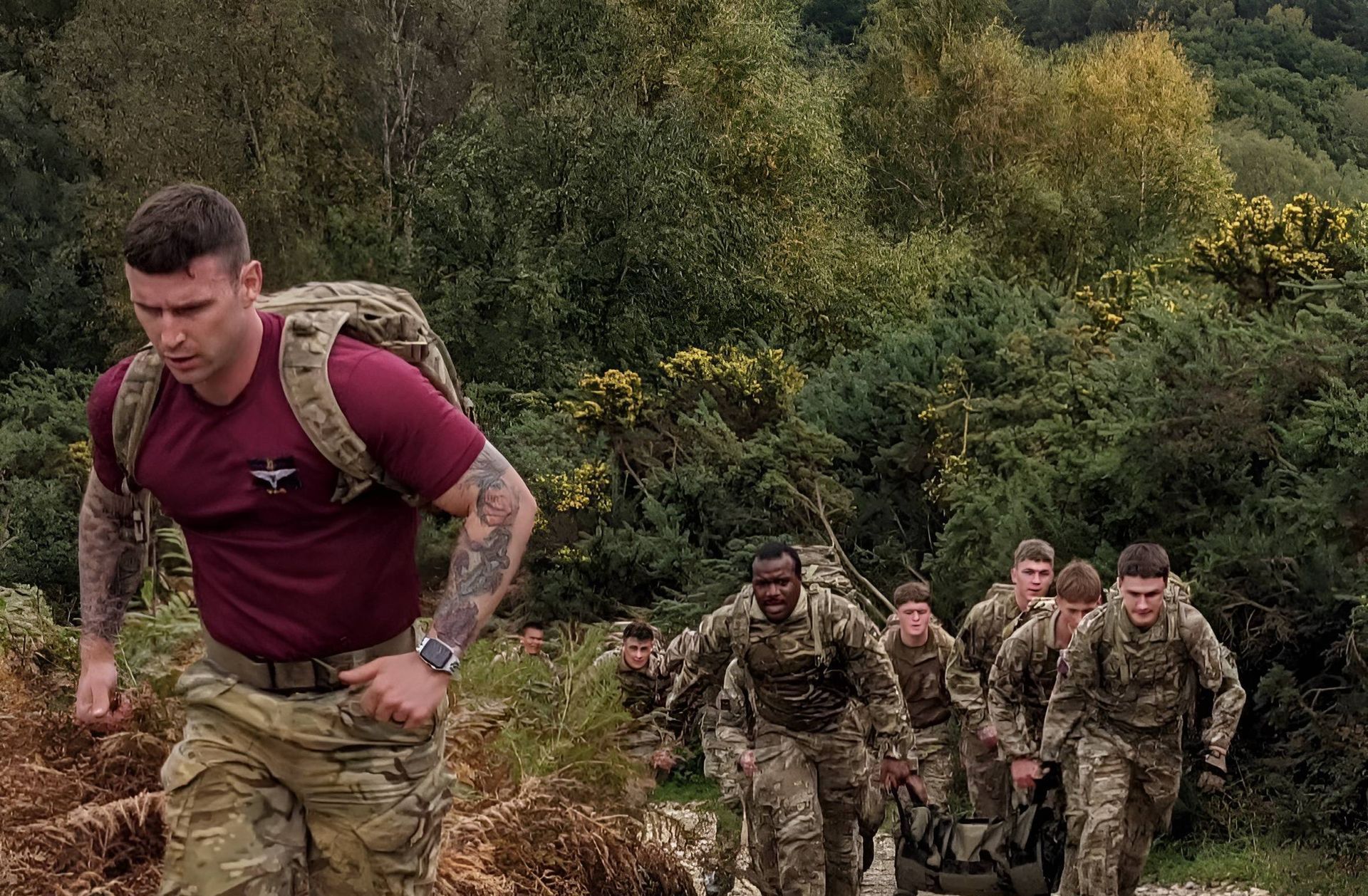
By Laura Barrigan
•
17 Apr, 2024
Rebuilding Tactical Athletes - The Return To Load Carriage Military Physical Fitness is defined as: ‘the ability to perform military tasks within the Army to meet Operational requirements in the Firm Base and Overseas’. The level of fitness required to carry out these military tasks varies depending on the job the person is doing. Although people do a wide variety of tasks both at home and on operations, the requirement to be able to wear body-armour, webbing and carry a weapon remains the same. These things can get heavy for some people, but the more efficiently you can move carrying extra weight, the easier the task becomes. In the world of exercise rehabilitation, our aim is to get people to return to “normal” training. In the British Army this requires a return to load carriage – carrying weight while completing tasks. Having followed a thorough strength cycle, returned to plyometrics/impact, completed a return to running programme, and integrated speed/agility and change of direction training into their programme, load carriage is typically the final piece of the puzzle. But how do you/we know if you’re ready for load carriage? Some say you have to “earn the right” to put weight on your back and start tabbing. I hate that phrase and the messages it implies. However, there are some simple tests you can use to help reduce the likelihood of an injury on the introduction of load carriage. If you can hit certain numbers on these tests, you’re ready. Lower body strength can be tested as a 1 rep-max back squat. Like any exercise, it’s vital to pay attention to your form during the squat. Is the individual able to hit 90 degrees? Are the knees folding inwards? Are they experiencing any pain during the movement? These are all simple things that we mustn’t forget. We expect individuals to have a 1 rep max (this can be an estimated 1 rep max) of at least bodyweight, but ideally 1.5x bodyweight. We test lower body explosive strength through a simple broad jump, aiming for a jump of 150cm and finally we need to test single leg lower body explosive strength through a single leg hop test. This is often thought of as the most important factor in the return to running and tabbing. It’s not uncommon for us to have one stronger side than the other but they are normally broadly even. Post injury, the recovered side can be weaker. For your average person going about daily life this might not affect them, but for a tactical athlete this can have huge implications to training. Walking, running and tabbing are single leg activities. You might not think of it like that, but it is. Every step is a single leg exercise and if our legs aren’t similar in strength, we will either use one side more putting additional pressure on that side, or drag the weaker side along increasing the risk of injury/re-injury. A single leg jump for distance can be measured and a limb symmetry index (LSI) established (a percentage difference in performance between L and R). We want the LSI to be higher than 90% to show there isn’t a large difference in single leg explosive strength. If it’s higher than 90% this shows we have the potential to use both legs equally when we run or tab. This criteria isn’t the be all and end all of entry to load carriage but it does provide some simple markers to aim towards. As with everything in the world of physical training, we adapt to the individuals and with the right training programme we can recover from injuries and make sure we don’t suffer further injuries going forward. If you have any questions about load carriage, please feel free to contact us.
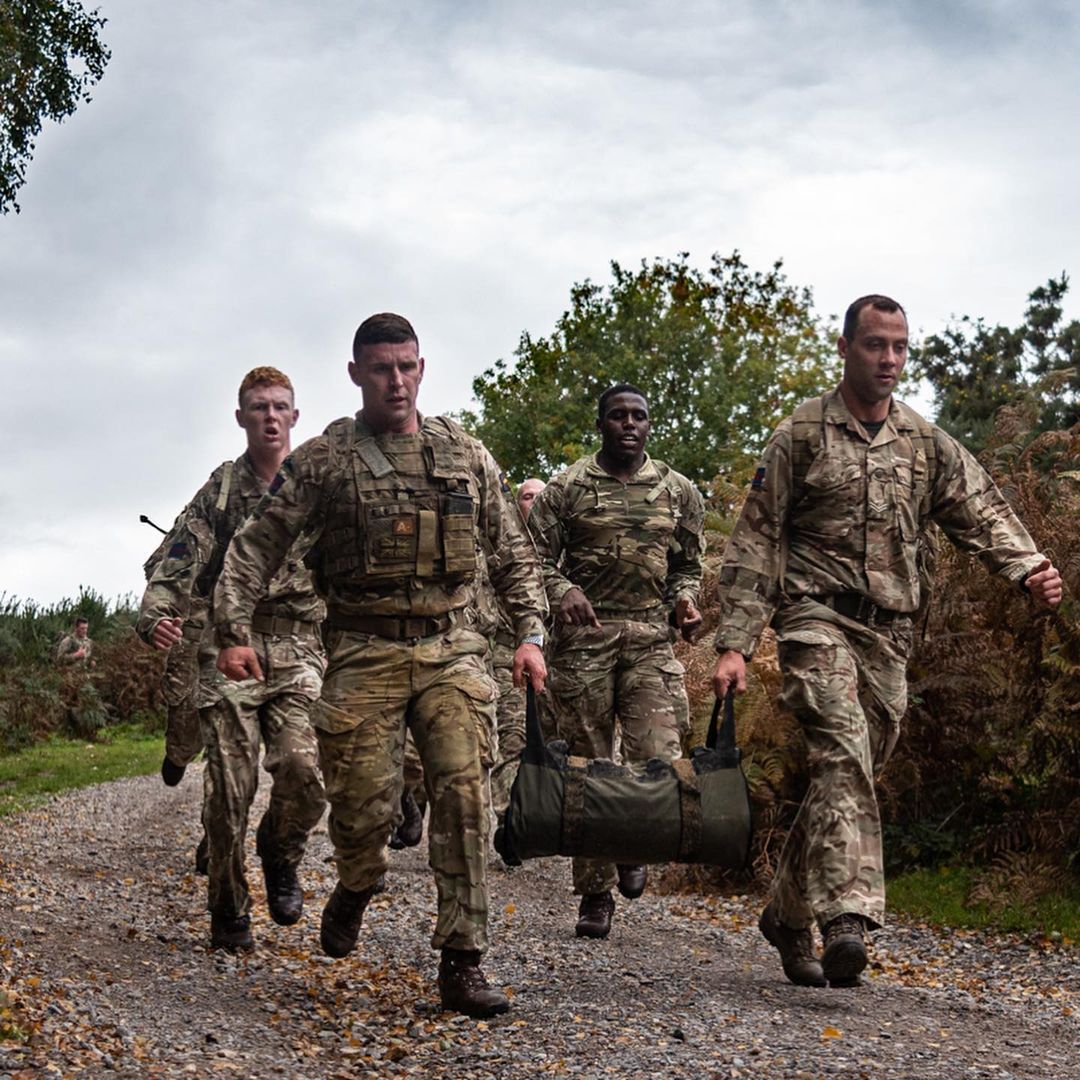
By Farren Morgan
•
09 Apr, 2024
Bleep Test – Expert Tips and Tricks to Score High What is the bleep test? The bleep test, or the multi-stage fitness test, is a fitness assessment used by the British Army to evaluate an individual's cardiovascular fitness and endurance. The test involves running back and forth on a 20-meter track within a set time frame. The participants start at one line, wait for the beep, and then run to the other line before the next beep sounds. The time between beeps progressively shortens, which means you must increase your speed over time. Each stage lasts approximately one minute. Keep in mind that the intervals between beeps get shorter with each level. If a participant fails to reach the marker before the beep, they receive a warning. The test is scored by the level and number of shuttles (i.e., 20-meter runs) completed before you can no longer keep pace with the beeps. The higher the level achieved, the better the aerobic fitness. The British Army uses the bleep test as part of its physical fitness assessments for recruits and serving personnel. The required level to pass varies based on the role, age, and gender of the individual. Specific requirements may change. However, a higher level of fitness is expected for combat roles. Scores required for different roles in the British Army The British Army uses several fitness assessments, including the Multistage Fitness Test (Bleep Test), as part of the joining process for both soldiers and officers. The specific bleep scores required are tailored based on the role and unit. For instance, more physically demanding roles such as those in the Ground Close Combat (GCC) sectors might have higher fitness standards compared to other roles. Related – Check out our other article about the Soldier Conditioning Review (SCR). As per the new Physical Employment Standards, the fitness requirements are designed to be objective, role-related, and without any differentiation based on age or gender. These standards aim to ensure that personnel can safely and satisfactorily complete the required tasks related to their specific roles without being at risk of musculoskeletal injuries. Some general scores needed for specific roles include: · Most soldier roles – Score Required (7.1) · Infantry – Score Required (8.7) · Parachute Regiment – Score Required (11.6) · The Army Foundation College – Score Required (6.7) For detailed requirements for different roles, it's recommended to use the Army's role finder tool on their official website or to consult specific recruitment materials. Since the content and standards of the Role Fitness Test (Entry) (RFT E) are being refined and may undergo changes for different arms within the British Army, the best way to stay updated is to go through the official website. Here are some resources to help you: · Army Jobs · The British Army homepage Tips and tricks to score better on the bleep test Your score on the bleep test is essential to determine your aptitude for joining the British Army. To make sure that you score high, follow these tips and tricks: Understand the structure The bleep test involves running 20-meter shuttles between beeps, with the pace incrementally increasing. You will continue running until you can no longer keep up with the beeps. It assesses two anaerobic energy levels and one aerobic (this is similar to the energy systems used by sprinters, middle-distance, and marathon runners). Regular Practice It’s vital to incorporate the bleep test into your routine. This helps your body acclimate to the test's physical demands and mental rhythm. However, you must diversify your training methods to avoid monotony. Mixed Cardiovascular Training Incorporate a variety of cardiovascular exercises into your training. For instance, try to run long distances, short distances, and sharp interval training. Interval training should include activities where the rest period is significant, such as alternating 200-meter sprints with 200 meters of rest. This variety in training helps engage different energy systems relevant to the bleep test. Focus on your turn Another common pitfall to get over is poor turning technique. To improve your score, it’s recommended that you start pivoting one step before the turn line. In other words, your body should be oriented in the opposite direction on the final step of the turn line. This move trims the distance you cover per turn and significantly improves your score with minimal effort. Extend the Distance Add distance to your practice runs each time you train. This will provide you with a psychological and physical edge. For instance, train with a 22-meter shuttle instead of the standard 20-meter. During the actual test, distance will feel easier, which improves your performance. Pace Yourself One of the most critical strategies is to pace yourself according to the beeps, especially in the early stages. Rushing to the line and waiting for the next beep drains your energy and disrupts your rhythm. Ideally, you would reach each line right as the beep sounds. Leverage Technology Use smartphone apps to measure distances and time your runs. Modern tools can substitute traditional equipment like measuring tapes or CDs. They also provide more accurate data and analysis, which allows you to focus on your weaknesses. Mindset and Recovery One commonly neglected aspect during bleep test training is mental preparation. Try to view each level of the test as a challenge to be met rather than a barrier will help you maintain a positive attitude. Practical Application During your training, try to mimic the test conditions as closely as possible. This includes the test’s physical setups and mobile apps to mimic the bleep test's auditory cues. The more familiar you are with the test environment, the more comfortable you will be during the actual test. Community and Support Contact others who are also preparing for the test. Training with a partner makes the preparation process more enjoyable and also introduces an element of competition and support. Takeaway message The bleep test is a key component of the British Army’s selection process. Scoring high in this test will increase your chances of getting your job goal. We hope that this article managed to introduce the bleep test as well as the best strategies to score high. If you have any questions about the bleep test, please feel free to contact me.
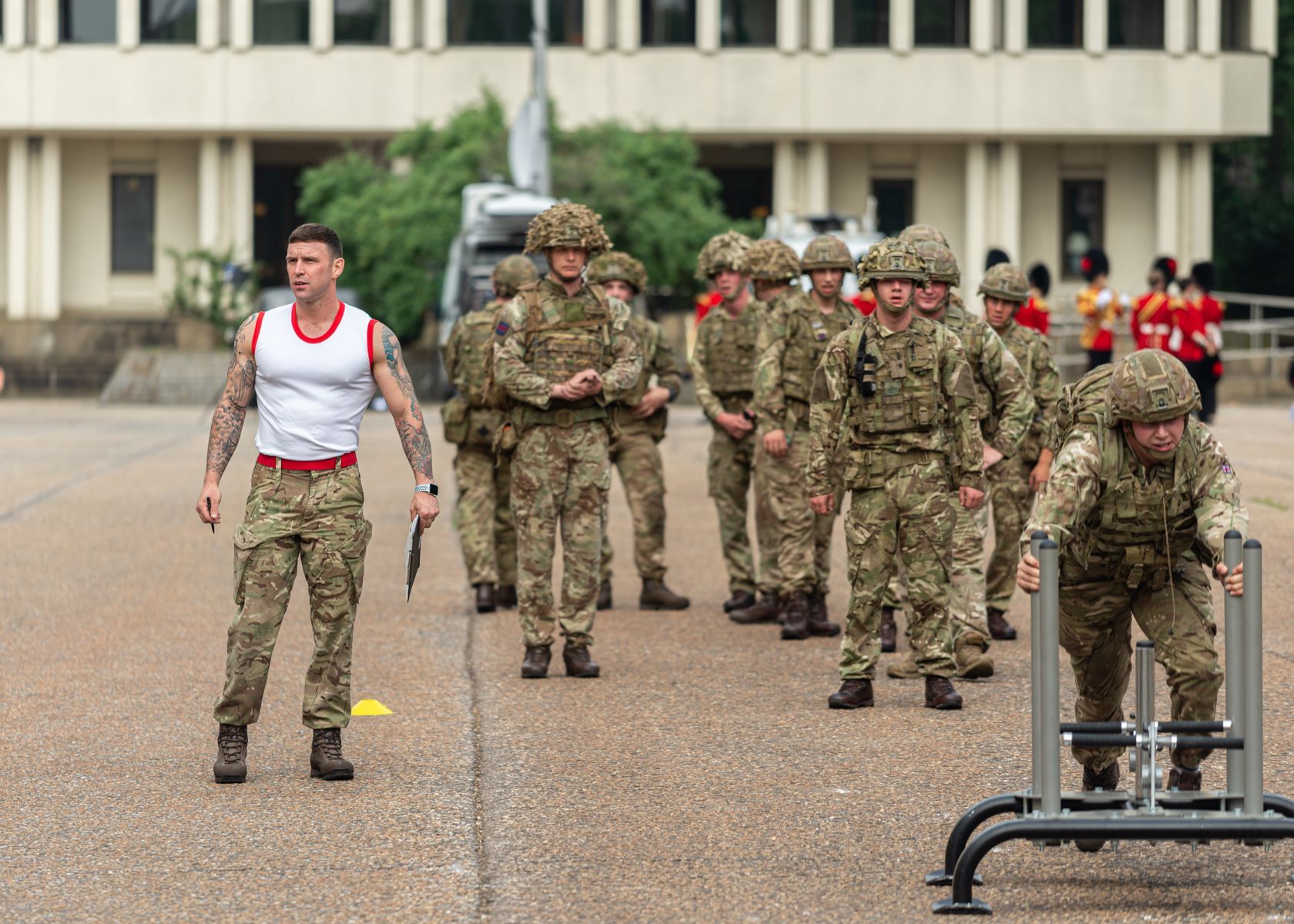
By Farren Morgan
•
03 Apr, 2024
Soldier Conditioning Review The Soldier Conditioning Review (SCR) is a comprehensive assessment that’s designed to evaluate the physical fitness of UK soldiers without any discrimination based on gender or age. The goal of SCR is to ensure that all soldiers meet the physical standards required for military tasks and operations. In this article, we will cover everything you need to know about Soldier Conditioning Review to get you ready. What is the Soldier Conditioning Review (SCR)? The Soldier Conditioning Review (SCR) is a strength and conditioning diagnostic tool used by the British Army. It is based on a simple idea – there are no gender and age biases. This gym-based assessment evaluates the individual's physical conditioning across all fitness components. The results of SCR will highlight your strengths and weaknesses in each area. Therefore, it allows Physical Training (PT) staff to tailor conditioning programs for both individuals and units. Since the 1st of April, 2019, all eligible Army personnel (Regular and Reserve members) are mandated to participate in the SCR. The SCR consists of a series of exercises that are designed to evaluate various aspects of physical fitness. These include: 1. Broad Jump to test lower limb explosive power. 2. Seated Med ball throw is explosive upper body strength. 3. Hex Bar Deadlift for lower limb strength. 4. 100m shuttles Lower body explosive power and anaerobic capacity. 5. Pull-ups to assess upper body strength. 6. A 2-km Run to test aerobic capacity. Together, these exercises give us a general view of an individual's physical capabilities and make it easier to improve weaknesses during fitness programs. The duration of the SCR The SCR is designed to efficiently assess a large group of personnel within a relatively short timeframe. This is important since all Army personnel must under go SCR. Therefore, it’s vital to make it time-efficient. For example, a group of 50 individuals can complete the assessment in about 90 minutes. Of course, this is just an estimation. The real assessment may take longer or shorter based on an array of factors. However, SCR focuses on time efficiency while ensuring that all tests are conducted thoroughly. The exercises of SCR and the scoring system The scoring system of SCR is based on a 90-point score. There are 6 exercises, each is scored from 1 to 15. Broad jump The broad jump exercise evaluates the explosive strength of your lower limbs. You'll start from a standing position, squat, and then leap as far as possible. Participants get a practice attempt, if the first practice attempt is unsuccessful you will be given a second practice attempt before undertaking the scored element which consists of two scored jumps – the best score will be recorded. The jump distances are measured in centimetres. There are specific benchmarks for passing. Seated medicine ball throw This exercise assesses the explosive strength of your upper body. You'll throw a 4kg medicine ball forward with full arm extension while sitting upright with your back against a solid surface. After a test throw, two attempts are made and measured in centimetres. Hex bar deadlift The hex bar deadlift focuses on the maximal strength of your lower limbs and back. You'll perform 3 to 10 repetitions. Each time, more weight is used to challenge your muscles. The scoring is based on an estimated one-rep max chart. 100m shuttle sprints This agility test consists of five 20-metre sprints that test your anaerobic capacity and agility. The assessment starts in the prone position behind a starting line, required to do alternating leg turns or make sure you look at the same direction every time you turn meaning you will switch the legs you take off from after initiating the turn. Practice attempt will be less distance but should be done at a high intensity and not a jog to prepare you for the assessment. The total time to complete the 100 metres provides a measure of the participant's speed and agility. Pull-ups Pull-ups test upper body strength, with one simple rule – You need to lift your chin above the bar from a hanging position. The pull ups are done under the timings of a metronome with 2 second spacings. The number of completed pull-ups performed to failure is noted. Half reps can be counted towards the score so 1.5 etc. You can only score a half rep after the completion of 1 full rep, you can't score 0.5 for example. There is no specific passing score since the ability to perform pull-ups varies greatly between individuals. 2 Km run The final test of SCR is the 2 km run, which evaluates aerobic capacity. It consists of a warm-up phase that’s followed by a timed best-effort run. The evaluation criteria of SCR The evaluation criteria for the SCR are simple. Each exercise within the SCR is marked on a scale from 1 to 15. After the completion of all exercises, individuals receive an overall score, which is categorized within an amber/green/red system. This scoring system facilitates the interpretation of your results: Green – It means excellent physical conditioning. Amber – It indicates satisfactory levels. However, some areas may require improvement. Red – It suggests that significant improvement is needed in certain areas. This method of scoring provides clear feedback to personnel, with an accurate evaluation of strengths and weaknesses. The exercises of SCR allows the testers to assess aerobic and anaerobic capacities, as well as other physical properties (e.g., speed, agility, resistance). Pass/Fail status As of its current review period, the SCR does not incorporate a traditional pass/fail system. This approach makes sense. You see, the SCR's main goal during its review phase is to gather data and insights into the physical conditioning of Army personnel without the pressure of immediate pass/fail. It also allows for an evaluation environment that’s focused on understanding the effectiveness of physical training programs. This non-binary evaluation method takes the Army one step closer to the modernization of physical training practices within the Army. What happens if you fail? If you fail in any part of the SCR, that doesn’t necessarily mean disqualification. Once again, the SCR’s goal is to gather data. Therefore, testers may offer you a retest between 48 hours to 7 days. Keep in mind that repeated failures will lead to a medical check up from the medical officer and therefore directed into the correct stream of PT dependent on any issues that may have been found. Finally, the SCR's standards and scoring might evolve as more data is collected. Takeaway message The SCR is a relatively new physical evaluation that pinpoints strengths and weaknesses in Army personnel. Although there is some vagueness regarding its pass/fail status, things might change when more data is collected and analyzed by the testers. We hope that this article managed to highlight what you need to know about the soldier conditioning review and how it evaluates Army personnel. If you have any questions about the SCR or other Army tests, feel free to get in contact with me. I am always happy to help!
